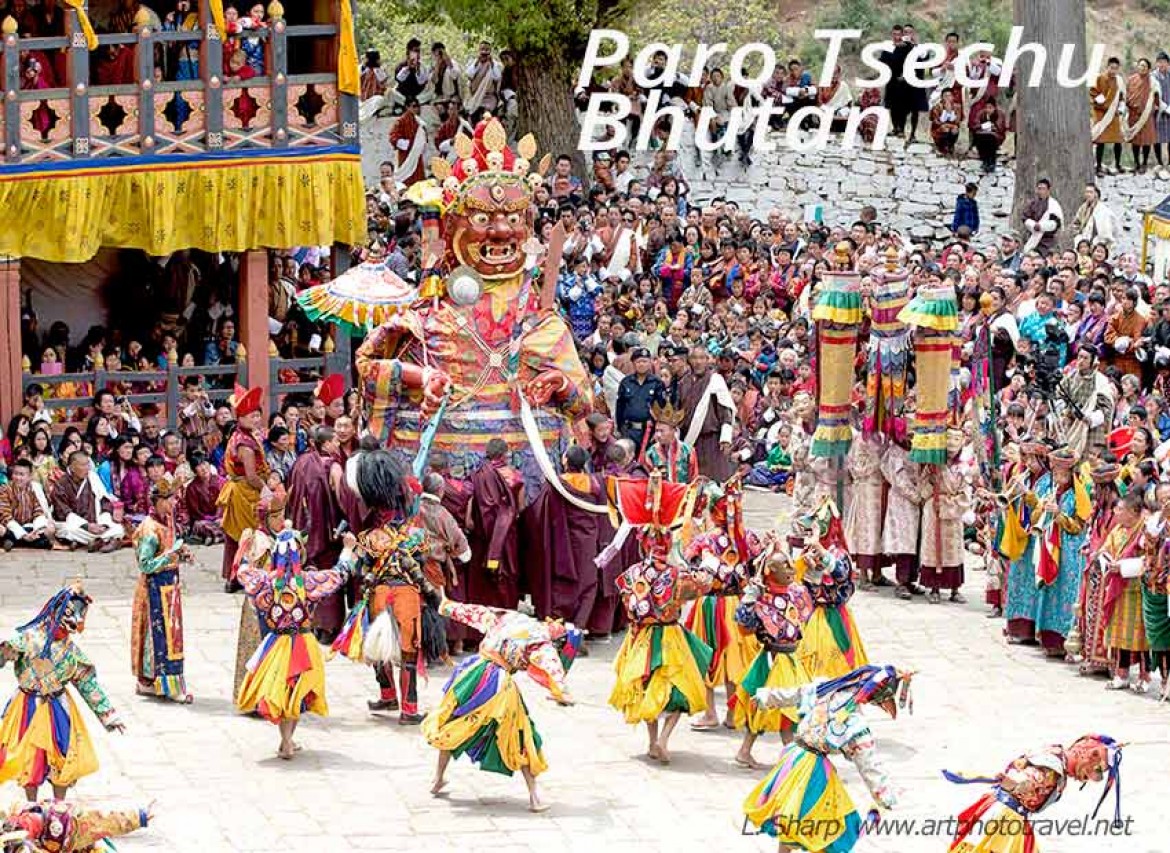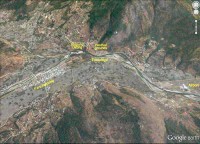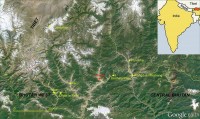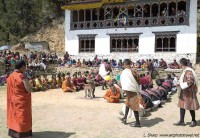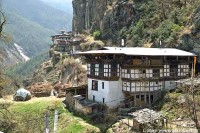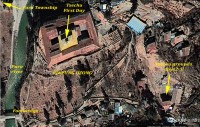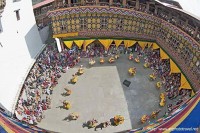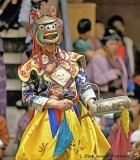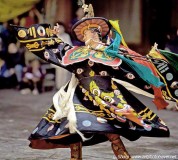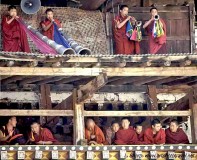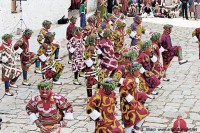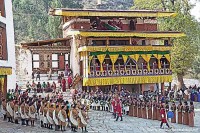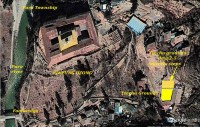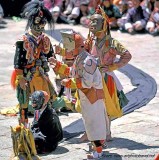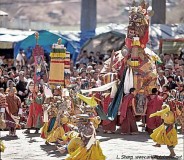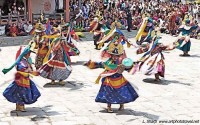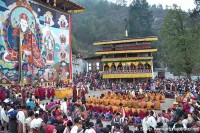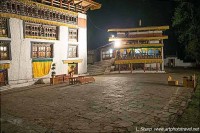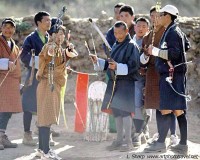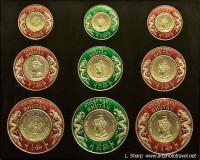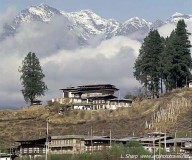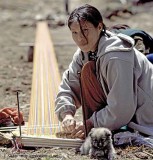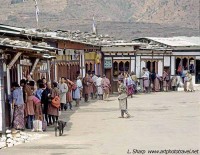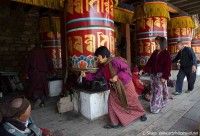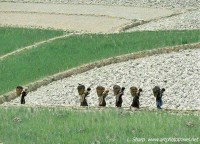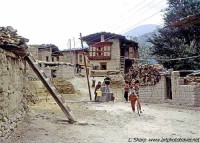The Paro Tsechu and other Bhutan Highlights
Overal Impressions
One of the great impressions of Bhutan is the observing their historic culture and customs interacting with the rapid globalization of our modern world. This can be seen in the new buildings of Paro and more so in the capital Thimpu which struggles to maintain its reputation of being the only traffic light free capital. But it is during their Tsechus, the annual religious festivals, where one can sit with the locals dressed in their finery, and experience the pomp and ceremony of an ancient Tibetan Bhudist festival. The largest of these Tsechus is held in Thimpu and in the 5-day Tsechu of Paro.
The Start of the Paro Festival
The beginning of the Paro festival starts in Dzongdrakha a small village situated at elevation 8,300ft, over looking the terraced fields of Bondhey, some 30 minute drive from Paro on the road to the Ha valley. The Tsechu is held on a flat field, a short distance from its Dzong whose four 16 Century temples cling precariously to the side of the mountain. It is a smaller version of the Tiger Nest monastery (Taktsang), founded by Guru Rinpoche. Although this Tsechu is much smaller than at Paro, it is more informal and intimate and we were the only foreign visitors.
The morning session started at 9:30 am for the masked dances that included The dance of the lord of death and his consort (Shinji Yab Yum). The Dance of the Lord of the cremation grounds (Durdag) and The dance of the Stags (Sha Zam), with each dance taking about 45 minutes. The local laypeople partook in traditional song and dances in between the religious masked dances. The Tsechu has a major religious significance for the locals, but it is also a great opportunity for family get to gather and dress in their best clothes with the women wearing stunning embroidered silk dresses and the men traditional costumes. We were the only foreign visitors present. By one o’clock, it was hot and the sun fierce with high UV component requiring sunscreen to prevent sunburn. I noticed none wore hats although some put napkins over their heads for protection. We left soon after.
The 5 Day Tsechu in Paro
First Day of Paro Tsechu
The Tsechu was held within an open air courtyard inside the Rinpung Dzong, a massive fortress that dominates the Paro valley. The buildings surrounding the courtyard were ornate in typical Bhutanese style, but the ceremonial area was small and became very crowded. I wore a tie and jacket, as all the locals were dressed in their finery and best clothes of national costume. There were very few good photographic positions available where one could stand, and these were occupied (including me) by 7:30 am for a 9 am start. Note, only 3 sides of the courtyard were available for spectators, with the people in the front row required to sit crossed legs on the ground. From these sitting positions, only close up photographs were possible as the large number of dancers obstructed any overall view.
Early in the morning the whole courtyard is in shadow, but by mid morning the light varied across the courtyard from deep shadow to direct sunlight. In the early afternoon, the shadow-direct sun positions swapped sides.
Paro Tsechu Days Two to Five
The remaining four days of the Tsechu were held outside, in the festival grounds just above the Dzong Fig4, where there was a small square bounded by an amphitheatre on two sides seating the spectators.
The program advertised a 10am start, but on most days the Tsechu started early between 9:am and-9:30 am. Overall, the schedule kept to the printed program, finishing around 3:15 pm.
I was told that all the individual dances are different but to the casual observer they appeared to be variations on a number of distinctive dances.
The Paro Tsechu Day 2 Outside the Rinpung Dzong
The location of the festival grounds for days two to five is shown in yellow in fig 8. On the left were concrete steps which provided good positions for photographing the festival. These seats faced south and both the spectator seats near the building and the performance area were in shadow until noon (shielded from the sun by the official building) after which the grounds and seating became fully exposed to the sun.
The Tsechu started around 9:30 am. For the best positions, one should be seated by 7:30 am. By 8:00 am, most lower seats were reserved or taken. The Tsechu lasted till 3:15 pm.
As the queen mother of Bhutan attended the morning festivities three victory dances (eg Fig9) performed by the military commemorating the 2003 search and apprehension inside Bhutan of Indian intruders, were added to the program on the suggestion of the queen mother.
Highlights of Days Two to Five
The highlights over the four days were:
♦ The Black Hat Dance (Shanag Cham): the only non masked dance. It is performed by 12 monks who perform the sacred Thunderbolt Steps that protect the faithful from harm.
♦ The dance of the lord of death and his consort (Shinje Yab Yum), where a giant puppet of the Great Shinje Fig11 was escorted on the shoulders of priests to his throne on the square, where later the faithful came to get blessed by the priests,
♦The enactment of the judgment of the dead Fig12, where the soul of each man was weighed to determine the future of his soul. You could feel the tension in the audience.
♦The ceremony on the last day, where around 3am in the morning, the Thongdrel of Guru Rincpoche, a huge embroidered silk tapestry, was unfurled for the final rituals and dances Fig13. The proceedings had to be concluded before sunrise, before the rays of the sun touched the tapestry.
♦The dance of the Lords of the Cremation Grounds (Durdag)
♦The dance of the Drum (Dramitse Ngacham)
♦The dance of the Eight Kinds of Spirits (Degye)
Over the period of the Tsechu, I found a number of the dances were repeated or appeared to be highly similar, so on some afternoons I did slip out to visit some of the other places of interest surrounding Paro.
Paro Tsechu day 4
This is an important day, particularly with the parade of the Great Shinje, Lord of Death, around the ceremonial grounds and the Day of Judgement, where the souls of the dead are judged to be good or bad. Following this enactment, The line of local people queuing for a blessing from the monks stretches all the way to the entrance of the ceremony grounds. It will get very busy and seating will be very scarce. A good overall position for viewing the parade of the Great Shinje (a three metre high puppet of the lord of death held aloft by an entourage of monks), is on the left on the concrete stairs (see Fig8) and part way up facing the concrete steps.
One must be in position by 7:15 am. By 7:45 most seats are occupied or reserved. Start time is around 9:30 am, finishing by 15:30 with the most impressive dances in the morning.
Paro Festival day 5.
The final day of the festival, involves the unfurling a giant tapestry (thongdrel Fig14) over the side of the official building, religious incantations and the blessing of the monk cadre. The festival starts at 4:0 am and lasts until mid afternoon, but in my opinion the highlights occur in the very early morning before the thongdrel is carried away following sunrise.
To get a good photographic position one should be in-position by 1:30 am (see Fig13) on the concrete steps on extreme left hand side (the last seat) facing the steps, where one can stand and set up a tripod without blocking spectators. Another place where one can stand (using a monopod) is in the front row to the side of where the head monk dressed in gold sits on a dais facing the ceremonial grounds and the thongral. By 2:00am all the best positions are taken. It will become extremely crowded by dawn with barely any room to stand or sit.
Highlights.
Showing of great thangkha (thongdrel)
Performance of the Shugdrel ceremony
The king and queen of Bhutan came to be blessed at the conclusion of the Shugdrel ceremony.
Dance of the Heroes (Pacham)
Dance of the Eight Manifestations of Guru Rinpoche (Guru Tshen Gye)
The tapestry is usually rolled up soon after sunrise, but on this occasion this was delayed until after the departure of the king.
Some Other Bhutan Highlights and Excursions.
♦ Bhutanese stamps.
I was most impressed with the collection of Bhutanese stamps. There were talking stamps in the form of miniature records that could play the national anthem, jigsaw stamps that formed a photo of an English football team, Holographic stamps, scented stamps, sculptured stamps, small stamps, large stamps. I was so impressed that I went and purchased of a set of 1975 gold embossed round stamps Fig9. at the Thimpu weekend market.
♦ The National sport of Target Archery.
Target archery is very popular in Bhutan. Not the normal kind of archery conducted over the Olympic spacing of 70 paces, but an archery competition held over a distance of 140m. From where the archers stood, I could barely make out the circles on the small target. The Bhutanese seemed to have the same problem, as team members stood preciously close to the target shouting instructions to the competitor. The bows they used were not traditional wooden bows, but high-tech Olympic archery bows.
♦ Haa village via the Chele-la Pass.
I went on a one day excursion to the village of Haa in the adjoining valley via the Chele-la pass at 3900m. The 45km approach to the pass was one of constant switchbacks through pine forest and Rhododendron stands, with some clearings which provided panoramic views of the Paro valley. I was surprised how massive the mountains were in this region. At the pass, the landscape was more open with snow on the ground, prayer flags flapping in the wind and there was a panoramic view of the snow peaks with the sacred mountain of Jomolhari (7314 m), located 50km away on the Tibetan border. I got out and walked around in the snow. It didn’t take long before the effects of altitude took hold, and I had to slow to catch my breath. The guide told me the Chele-la was the highest road pass in Bhutan. The rest of the journey to Haa took about an hour and half, passing a few isolated hamlets, some Yaks grazing in a field, and many dogs.
Haa lies in a narrow valley with steep heavily forested slopes. A small river flows through the valley floor, and there is a number of scattered temples and Dzongs including the 7th century white and the black Temples guarding the southern entrance of the valley. The township is compact and small; it has traditional buildings and can be traversed by foot in a few minutes. The village had a more frontier feel than Paro, and there were farmers working in their fields of millet and barley.
♦ Thimpu, Bhutan’s Capital.
I overnighted in Thimpu, (a 6 hour drive from Paro), on the way to Wangdue Phodrang in central Bhutan and again on the way back.
Located in a shallow valley at 2350m elevation, Thimpu had that special feel of a small mountain town, with many examples of classical Bhutan architecture, but the downtown area had incorporated a lot of the global trappings.
At the Memorial Chortan, (for the late King Dorji Wangchuk) I enjoyed the spectacle of enormous prayer wheels being turned by older citizens, who with their other hand were spinning personal prayer wheels, all the while chanting mantras.
♦ Visit to Central Bhutan via the Duchula Pass.
I took an extended day excursion to the area around Wangdue Phodrang, a small town with white washed wooden shops and restaurants in Central Bhutan. I found the small farming villages and the visit to a traditional farmhouse very photogenic and attractive and would have enjoyed staying in this area a few days longer.
On the way we stopped for tea on the Duchula pass at 3050m with its fluttering prayer flags, 108 small stupas, expansive tea rooms and snow on the ground. It was cold under a clear blue sky. The air felt thin and a little windy, but I loved the feeling. The Duchula pass was a good vantage point from which to view the distant Himalayan snow peaks on the Tibetan border some 80 Km to the north.
Some General Observations.
♦ Travel to Bhutan is only open to groups. But you can go in a group of one. The group will be afforded a guide, a car and driver, and assigned hotels, all for a fixed daily rate.
♦ If you want better accommodation or want a particular hotel, then there will be additional fees.
♦ The assigned guides can be of varying experience. The tourism council of Bhutan lists the tour guides, and senior tour guides and their tour operators or townships at http://www.tourism.gov.bt .
♦ Airplanes can only fly in and out of Paro during the mornings when visibility is good, as clouds tend to form later in the day. Thus it is quite possible that the planes may be delayed or even cancelled for that day. So it is advisable to allow extra time at both beginning and end of the stay. If the departure is delayed for a day or more, then the government will bear the cost of the extra days.
♦ If the Bhutan visa needs to be issued from Bhutan, (copy can be emailed) then it will be sent about two weeks before arrival. This can be an issue if Bhutan is part of an extended international tour.
♦ Arriving from Delhi, Kathmandu, Kolkata , the best view of the Himalayan range is on the left hand side and departing on the right.
♦ I did not trek in Bhutan as I have previously spent a total of some 6 months trekking in Nepal.
♦ The sun can be intense, creating dark shadows and bright highlights, resulting in high contrast images. Fill-in flash will help, but must get advise from guide regarding social sensitivities.


